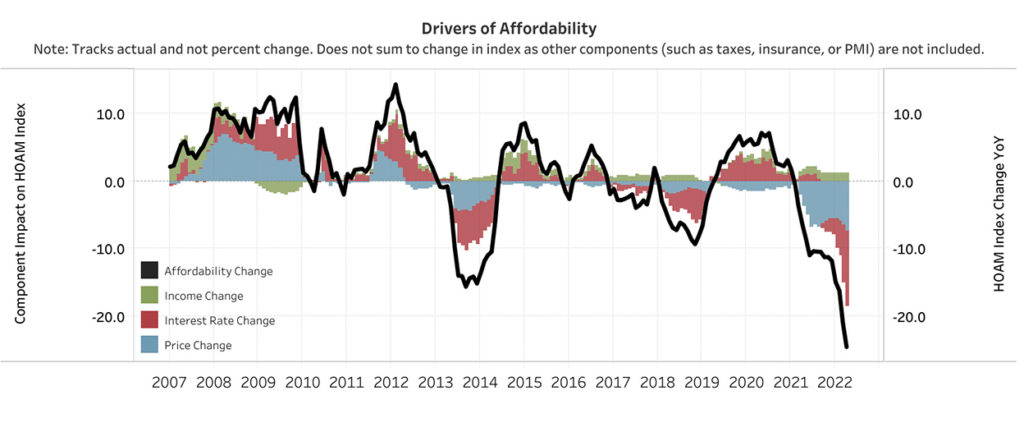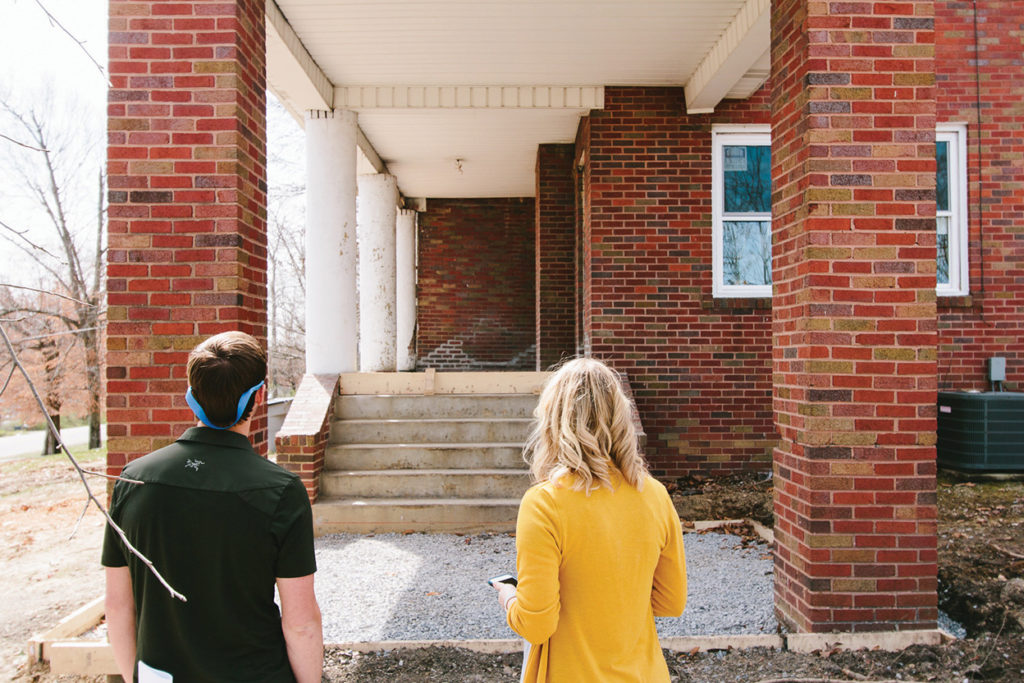
Interest rates are on the rise and a recession may be in our future.
What does that mean for home prices in our region?
By Dave Ongie
Leading up to the Federal Reserve’s June meeting, all indications were that something was going to have to give.
The inflation data from May showed consumer prices were continuing their sharp rise, which left the Fed feeling pressure to act to curb inflation even though it might be risking a recession in doing so. In the end, the Fed went above and beyond its measured plan to slowly raise interest rates by raising rates 75 basis points, its largest increase since 1994.
The move was not greeted enthusiastically by Robert Dietz, the National Association of Home Builders’ chief economist.
“Given signs of slowing economic activity, including six straight months of declines for home builder sentiment, a clear risk is that by falling behind the curve, the Fed will overshoot on tightening and bring on a recession as it fights inflation,” Dietz wrote in a recent piece.
As interest rates approach 6 percent with tightening expected to continue, the attention in our region turns toward how the higher interest rates will affect a housing market that has been red-hot since the onset of the COVID-19 pandemic. What qualifies as good news and bad news depends largely on a person’s perspective.
For those who have purchased a home in the last year or two, the obvious hope is that those homes retain their newfound value no matter what the economic outlook is in the coming years. On the flipside, those who have been sitting on the sidelines for the last two years hoping home prices come back down to historical levels will need the market to cool considerably.
That is especially true for renters, who are increasingly being priced out of the housing market altogether. The Harvard Joint Center for Housing Studies recently released its State of the Nation’s Housing report, which showed how the recent surge in home values further exacerbated existing housing affordability challenges.
“At today’s prices, the typical down payment that a first-time buyer would need for a median-priced home is $27,400,” said Alexander Hermann, a JCHS senior research analyst. “Without help from family or other sources, this would rule out 92 percent of renters, whose median savings are just $1,500.”
The Current Picture
In the wake of the Fed’s big move, housing data from the month of May showed very few signs that our local market was slowing down. Obviously July will bring with it numbers from June that will more accurately reflect what impact higher interest rates are having on our market, but May’s numbers showed prices continuing to trend upward.
According to a piece Don Fenley wrote for the Northeast Tennessee Association of Realtors (NETAR) on June 12, the forecast for price reductions coming to markets in other parts of the country don’t reflect the reality in our local landscape. In fact, Fenley said the median listing price rose from $234,950 in January to $274,900 in May. Likewise, the average listing price rose from $346,440 to $390,469 during that same span.
Fenley has also reported that the only sign thus far that our local housing market is cooling is that pending home sales declined in both April and May. Sellers accepted 19 fewer contracts in May than they accepted in April, and 62 fewer than they accepted in May of last year. But this only offers evidence that buyers who have lost out in bidding wars are simply heading to the sidelines and waiting to see if rising interest rates and a potential recession do anything to bring prices back down.
Matt Lavinder, president of Bristol-based New Again Houses, has been in business flipping houses since before the housing crash of 2008. In 2019, he started franchising his system of purchasing, renovating and selling houses.
“We launched that in 2019 with five locations, just before the pandemic,” Lavinder told the Business Journal. “It’s grown really fast, so now we’ve got 33 locations in 17 states. I’ve got my finger on the pulse of a lot of different markets across the country, so it’s been really interesting to see the pandemic play out and how it’s affected real estate.”
Although Lavinder flips homes, he has never been a speculator. Rather than rely on rising prices alone, Lavinder’s strategy has always been to add value through construction, which creates his profit margin. But even though the value added through construction helps insulate Lavinder’s business from falling home prices, he doesn’t expect home values to go down anytime soon.
“I do think the fundamentals are completely different this time than in 2008,” he said. “I think there have been a lot of variables in place that are driving these price increases.”
A recent report by ATTOM Data Solutions shows that there are areas around the country that seem vulnerable for significant market declines, but that is not the case in our region. ATTOM’s Special Housing Risk Report, which was released on June 22, showed the biggest cluster of housing markets at risk of losing significant value are located in the New York City and Chicago areas.
Overall, three states – New Jersey, Illinois and California – were home to 34 of the 50 counties most vulnerable to housing declines. On the other end of the spectrum, Sullivan and Washington counties were among the U.S. counties least vulnerable to housing market declines.
Fenley’s extensive regional data shows that while pending home sales and loan originations have been hit with declines as of late, home values continue to rise. But how long will that last?
Unyielding Demand
Much of Lavinder’s confidence that homes will retain their value for the foreseeable future is grounded in the simple principle of supply and demand. With 33 locations in 17 states, Lavinder has plenty of data to show that an influx of people to southern states like Tennessee is helping drive demand.
“It’s extraordinary how many people are moving here from outside, and they’re moving here from places where – even with our increased prices – homes are more affordable than where they are coming from,” Lavinder said. “And I think that’s going to continue. I don’t think we’re going to see that slowing down, that influx of people coming to our area. It’s not just our area – all of our markets are seeing appreciation.”
Dave Ramsey, a nationally syndicated radio host based in Tennessee, recently shared some statistics that back up the notion the current housing market might be recession-proof.
“Buyers are fewer in a bad economy,” Ramsey said on a video posted on his social media channels. “There are fewer buyers, but there have to be fewer buyers than supply for housing prices to go down. That’s not going to happen.”
According to the data Ramsey cited, there are five million more 35-year-olds right now – the prime home buying age – than there were in 2007. Likewise, there are 128 million households now compared to 116 million households in 2007, which means 12 million more households are in search of a home during a time when we have roughly half the housing starts we had in 2007.
“The number of buyers would have to go down so dramatically before housing prices would go down,” Ramsey concluded.

Faltering Supply
As Ramsey mentioned, housing starts are way down, and this follows a trend that has been in place each year since the housing crisis of 2008.
It is certainly something Lavinder sees on a daily basis, especially in the middle of the housing market. With that in mind, his model of buying houses in the midrange of the market and restoring them is being met with a lot of demand.
“There’s so much pent-up demand there and we just haven’t, as a country, been building affordable houses, so there hasn’t been any increased supply because of a lack of new construction at affordable price points,” Lavinder said. “I think it’s really catching up with us. It really caught up with us during the pandemic, and there’s a real imbalance between supply and demand right now, and it’s got a long way to go.”
There are a number of factors that are leading to a shortfall in new home construction despite the fact that there is a huge demand for homes, and that shows no signs of subsiding. Obviously the sharp increase in the price of building materials during the pandemic and an unreliable supply chain have slowed home starts. Regulatory hurdles and the lack of skilled tradespeople is also preventing the homebuilding industry from firing on all cylinders.
“When you look at the new construction that has happened, even here in the Tri-Cities, it’s larger houses because builders make their money on square footage,” Lavinder said. “It’s really difficult for a builder to come in and build a 1,200-square-foot ranch. The fixed costs are such that it’s really hard to do that without any government subsidies, so nobody has been building that, but yet, that’s the price point people can afford right now.”
Another factor that will continue to hamper both new home construction and home renovations is a lack of skilled tradesmen. The National Association of Home Builders sounded the alarm well before the pandemic to bring attention to the deficit of skilled labor in every aspect of the industry. Lavinder says the lack of skilled labor entering the workforce is also hampering his ability to renovate homes and bring them to market.
“I think the decreasing supply of skilled labor is probably the thing that is the biggest threat to all builders,” Lavinder said. “Your skilled tradesmen are getting closer to retirement, and you just don’t see young talent coming in to fill that gap.”

The Path Forward
Unless something changes drastically, it appears the demand for housing in our region will be addressed in a multifaceted manner that will change the landscape of housing as we have known it. By necessity, new housing being constructed will either consist of high-end subdivisions featuring homes with a lot of square footage or multifamily housing to help fill the need for affordable dwellings.
Infill housing, like the Westgate development in Kingsport, will likely become more commonplace as it becomes harder for cities to annex land to add residents. All in all, Lavinder believes most folks looking for affordable housing in our region will need to curb their expectations.
“I think people are going to have to sacrifice part of what their expectations were before the pandemic,” he said. “There just isn’t enough square footage to meet the demand. I was just in Europe for several weeks. I think that’s probably the future where people live in smaller spaces and give up square footage, they give up some privacy, some things we’ve probably grown accustomed to and taken for granted in the Tri-Cities.
“Something has got to give, and it’s probably going to be square footage. That’s the norm for the rest of the world, and we’ve probably taken that for granted here.”
Meanwhile, folks like Lavinder will continue renovating the existing housing stock and selling those homes to buyers looking for midrange options. The benefit of that, he says, are that folks can buy a home with confidence that they won’t be hit with a laundry list of repairs.
The same can’t be said for most folks who are living in the vast majority of midrange housing in our region that is aging quickly with deferred maintenance that accumulates with each passing year.
“We’re not going to make a dent in the solution,” Lavinder said. “The housing stock in this country at affordable price points is just old. Your housing stock, if you’ve got a 1,200-square-foot ranch, it was built in the 50s, the 60s or maybe the 70s. Those houses are 70 years old now.
“There is a lot of money that needs to go into them and not a lot of skilled labor or expertise to be able to execute on those projects. I don’t know where the solution is going to come from. I don’t know if builders can solve the problem because they have the same problem. It’s still really hard to build an affordable house without government subsidies.”




